Home / Opening of Epoxides With Acid
Alcohols, Epoxides and Ethers
Opening of Epoxides With Acid
Last updated: March 6th, 2025 |
Opening Epoxides With Aqueous Acid
- Epoxides can undergo ring-opening with nucleophiles under acidic conditions.
- In this reaction, the epoxide oxygen is protonated first, making it a better leaving group
- In the second step, the nucleophile tends to attack the more substituted carbon, which breaks the weakest C-O bond.
- The best analogy is that it is a lot like the Markovnikov opening of bromonium or mercurinium ions.
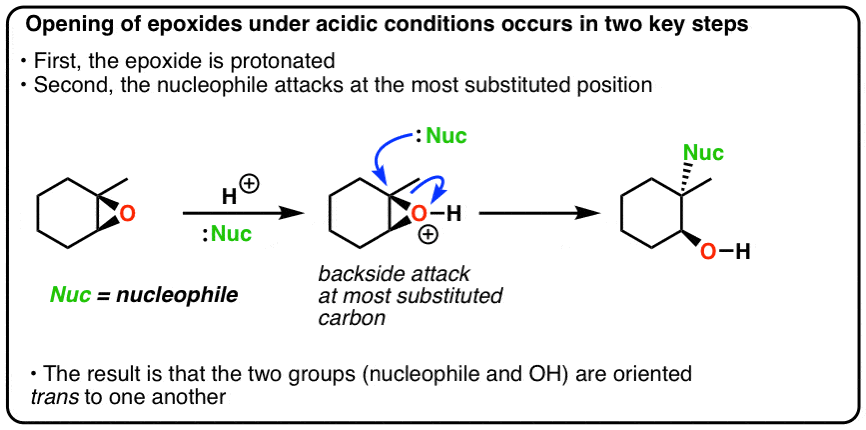
Table of Contents
- Formation of trans-Diols Through Opening of Epoxides With Aqueous Acid
- The Mechanism For Opening of trans-Diols With Acid Is Similar To Opening Halonium Ions
- Other Nucleophiles: Alcohols and HX
- Acid Only Helps The Reaction If The Nucleophile Is Compatible With Strong Acid
- What About Opening of Epoxides With Base?
- Notes
- Quiz Yourself!
- (Advanced) References and Further Reading
1. Formation of trans-Diols Through Opening of Epoxides With Aqueous Acid
In the last post, we saw some examples of how epoxides are considerably more reactive towards breakage than are ordinary ethers. For example, aqueous acid [often abbreviated “H3O+”] will open an epoxide under MUCH milder conditions than an “ordinary” ether such as diethyl ether, because epoxides have considerable ring strain [about 13 kcal/mol].
Looking more closely at the reaction, we also noted two interesting patterns:
- the nucleophile attacks at the “more substituted” position of the epoxide (C-1, below)
- inversion of stereochemistry occurs at this position, but not at the other position (note that the C-O bond at C-2 below is a “wedge” in both starting material and product ).

[By the way, how do we “know” that the OH on C-1 is from the nucleophile and is not the epoxide? Using isotopic labels is one way. Another is to use nucleophiles other than water – see below]
It should be noted that in the absence of acid, no reaction occurs. So clearly the H+ plays a key role.
What could be going on?
By analogy to the reaction of ethers with acid, the first step must be reaction of the most basic site on the molecule – the epoxide oxygen – with acid, giving us a protonated epoxide. This will function as a much better leaving group than does the unprotonated epoxide. [Recall that the conjugate acid is always a better leaving group]
The next step must then be reaction of the best nucleophile present in solution – H2O, in this case – with our protonated epoxide. And this occurs at the most substituted position, always with inversion of stereochemistry. So it must be performing a “backside attack” at this carbon, as we observe in SN2 reactions. A final deprotonation gives us the neutral product.
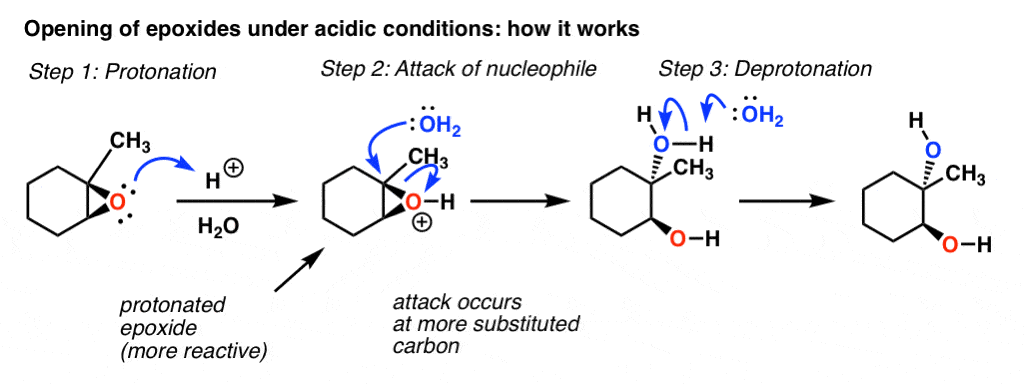
Hold on for a second. If you remember the key lesson of the SN2 – that it is disfavoured by steric hindrance – this might seem weird. If this was a “pure” SN2, reaction, wouldn’t we expect the attack to occur as the “least substituted” position?
Clearly something else must be going on here!
2. The Mechanism for Opening Epoxides With Acid Is Just Like Opening Halonium and Mercurinium Ions
Thankfully, you’ve likely encountered reactions like this before! If you think back to the chapter on alkenes, you might see that the protonated epoxide bears an uncanny resemblance to two other reactive intermediates you met in that chapter: “halonium” ions, and “mercurinium” ions, both 3-membered rings bearing a positive charge:

If you think back to how these species reacted with nucleophiles, it was always at the more substituted position with inversion of stereochemistry. In fact, there is a whole family of alkene addition reactions that proceed this mechanism that we called the “3-membered ring pathway“. Halohydrin formation is a perfect example:
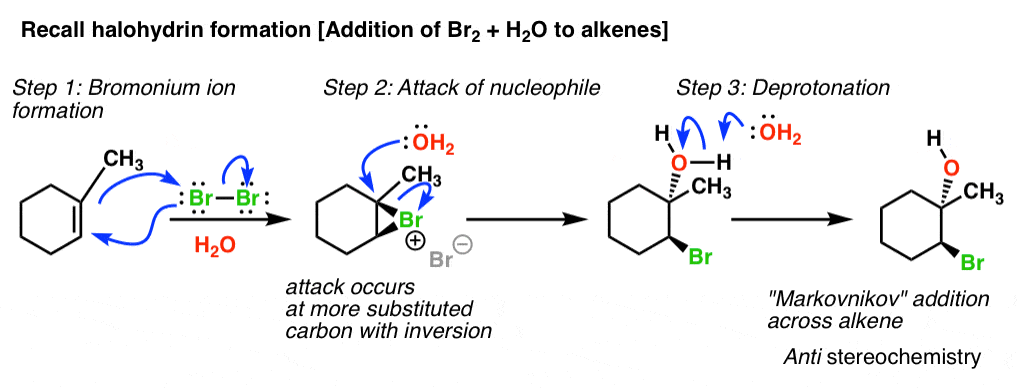
So in essence, the addition of nucleophiles to protonated epoxides is just another example of the “3 membered ring pathway” of alkenes!
[Need a review on why the nucleophile attacks the most substituted carbon? See Note 1 and then come back]
Now – we’ve seen that this works with aqueous acid [H3O+]. Can we extend this to other nucleophiles? Sure! With some reservations that we’ll get to in a second.
3. What About Other Nucleophiles? Alcohols And HX Also Work
Changing the solvent from water to an alcohol will result in the alcohol adding instead. For example if we were to use CH3OH as solvent instead of water, then our product would contain OCH3 joined to the most substituted position.
Hydrohalic acids [HCl, HBr, and HI] can also work well, forming halohydrins.

4. When Doesn’t Acid Help? When The Nucleophile Is Not Compatible With Strong Acid
Now, you might think – if epoxides are made more reactive by treating with acid, then can’t we extend this to other nucleophiles too? For example, what about NaOH, or NaNH2, or even Grignard reagents?
Herein lies the dilemma. Acidic conditions are only compatible with nucleophiles that are protonated reversibly. [in other words, nucleophiles whose conjugate acids are strong acids – think pKa < 0 ]. [Note 2]
Can you see a little problem with adding NaOH to a solution of aqueous acid? What do you think might happen?
Kaboom. Well, that’s an exaggeration. But the acid will protonate NaOH irreversibly, giving us H2O [recall that acid-base reactions are fast]. Similarly, you can imagine what happens on adding NaNH2 to acid or Grignard reagents to acid: the nucleophile is protonated, giving us the conjugate acid.
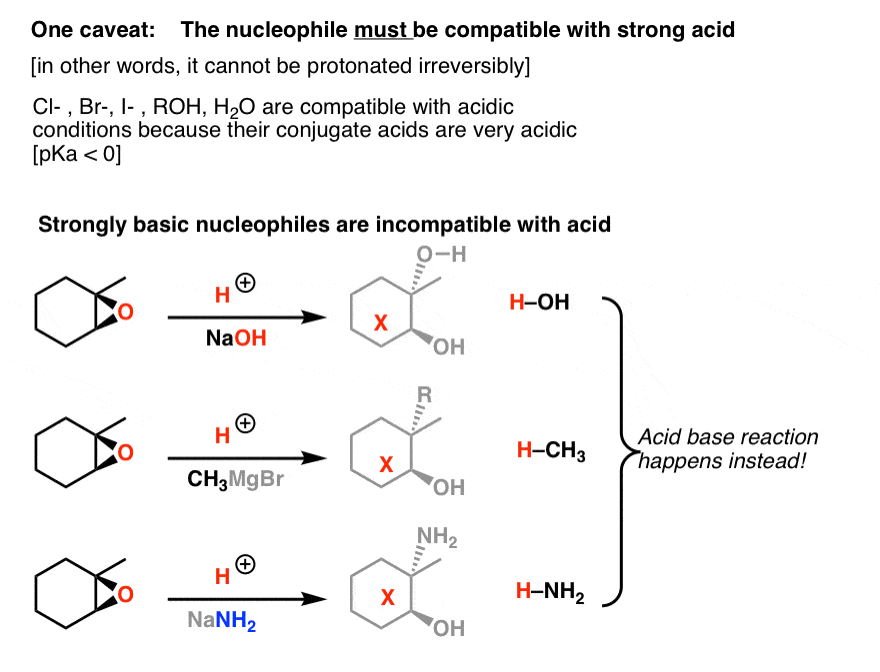
5. What About Opening Under Basic Conditions?
There’s still one mystery to solve. From the last post you might recall that if we just add NaOH – no acid – to the epoxide we met above, we get a different product altogether.
Note how the stereochemistry at C-2 is completely different than with acid.
What might be happening here? Any thoughts? Hint – it’s a reaction we’ve talked about before, and even mentioned in this post.

We’ll talk about this in the next post.
Next Post – Opening Of Epoxides With Base
Notes
Related Articles
Note 1: Why does the nucleophile attack the more substituted carbon?
- In our protonated epoxide, although oxygen bears a positive formal charge, in reality positive charge density mostly resides on carbon [recall that oxygen is more electronegative than carbon].
- Recall that positive charge is best stabilized by carbon in the order tertiary > secondary > primary. So in our case, the tertiary carbon atom will bear more positive charge. The tertiary carbon will be more electron-poor (electrophilic)
- The length of the C-O bonds will NOT be equal – the C-O bond to the tertiary carbon is longer and weaker than that of the secondary carbon.
Bottom line: the tertiary carbon is more electrophilic (electron poor) and the C-O bond on the tertiary carbon is weaker, longer, and easier to break.
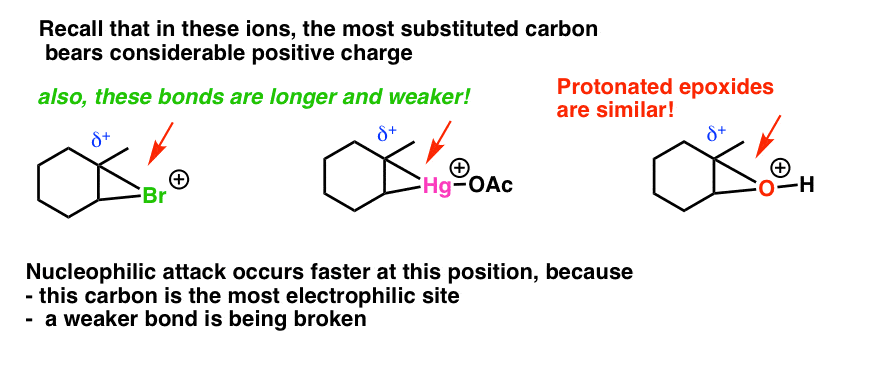
Note 2. These diagrams by Matt McIntosh in the same context are very helpful. [back to discussion]
Quiz Yourself!
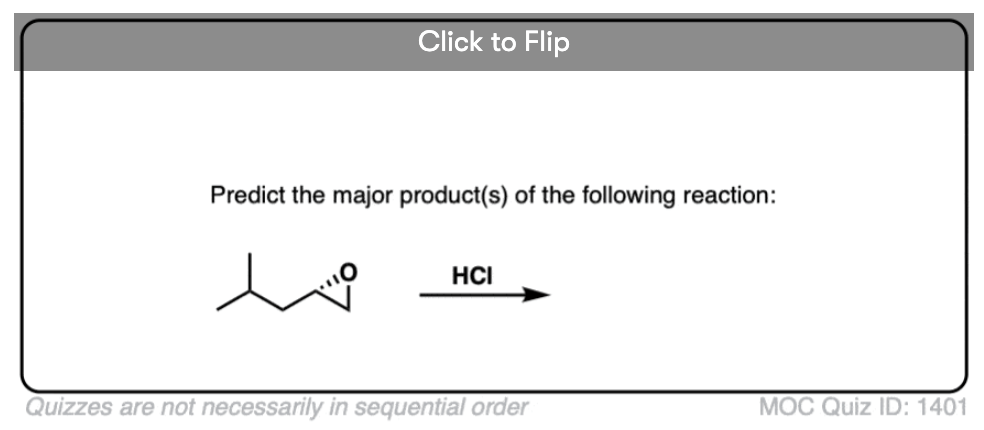
Become a MOC member to see the clickable quiz with answers on the back.
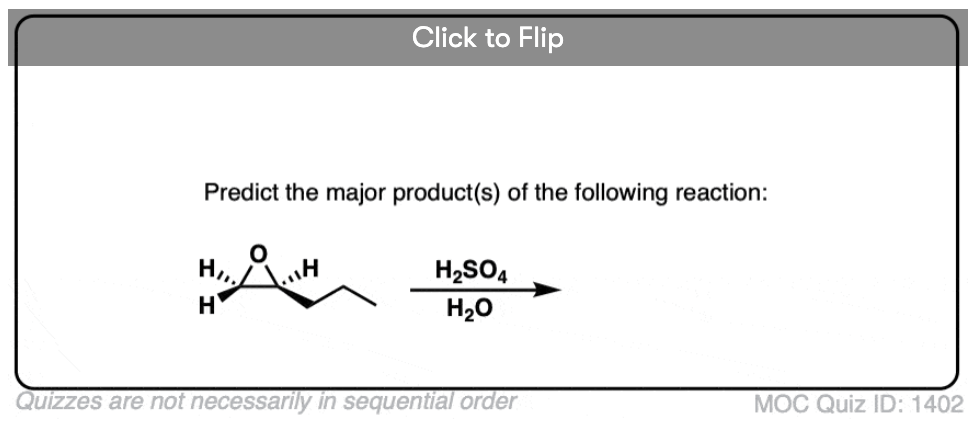
Become a MOC member to see the clickable quiz with answers on the back.
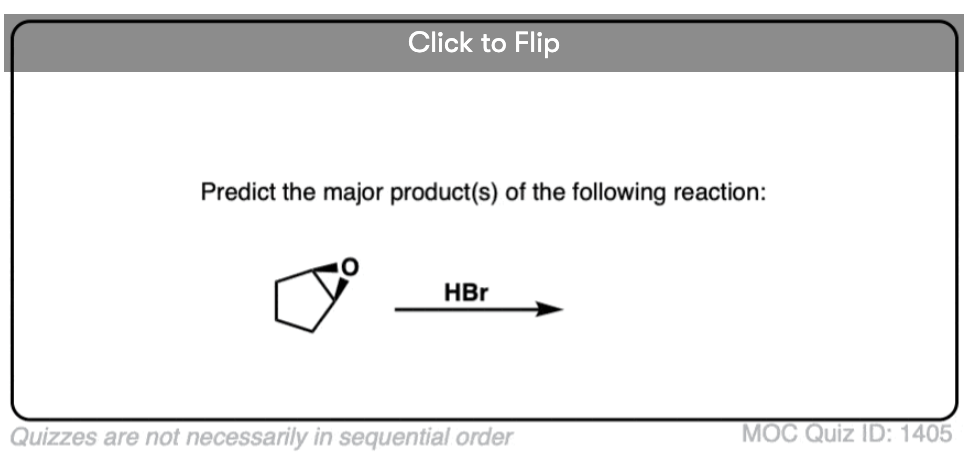
Become a MOC member to see the clickable quiz with answers on the back.
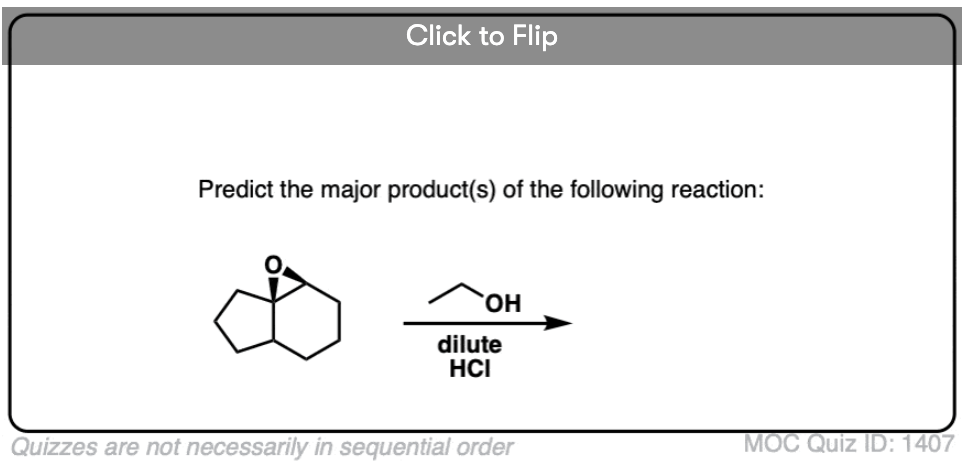
Become a MOC member to see the clickable quiz with answers on the back.
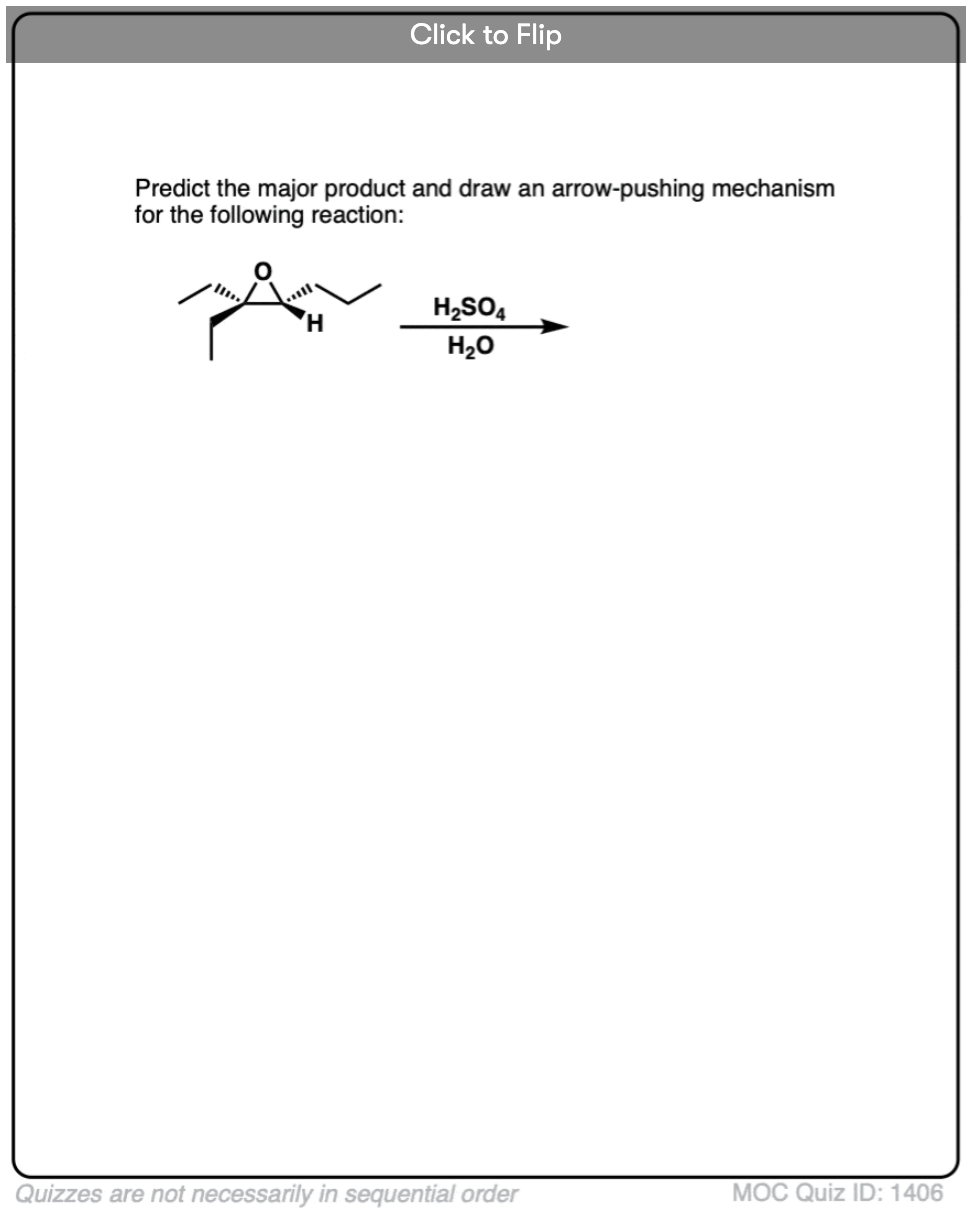
Become a MOC member to see the clickable quiz with answers on the back.
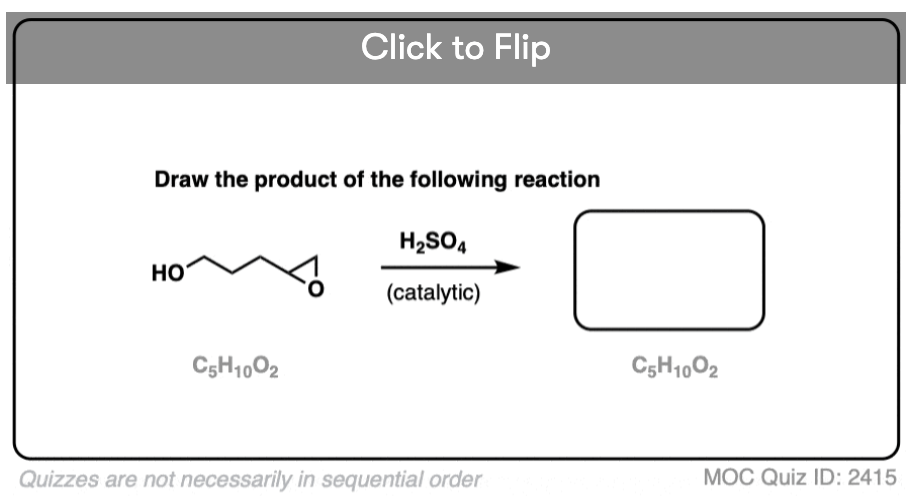
Become a MOC member to see the clickable quiz with answers on the back.
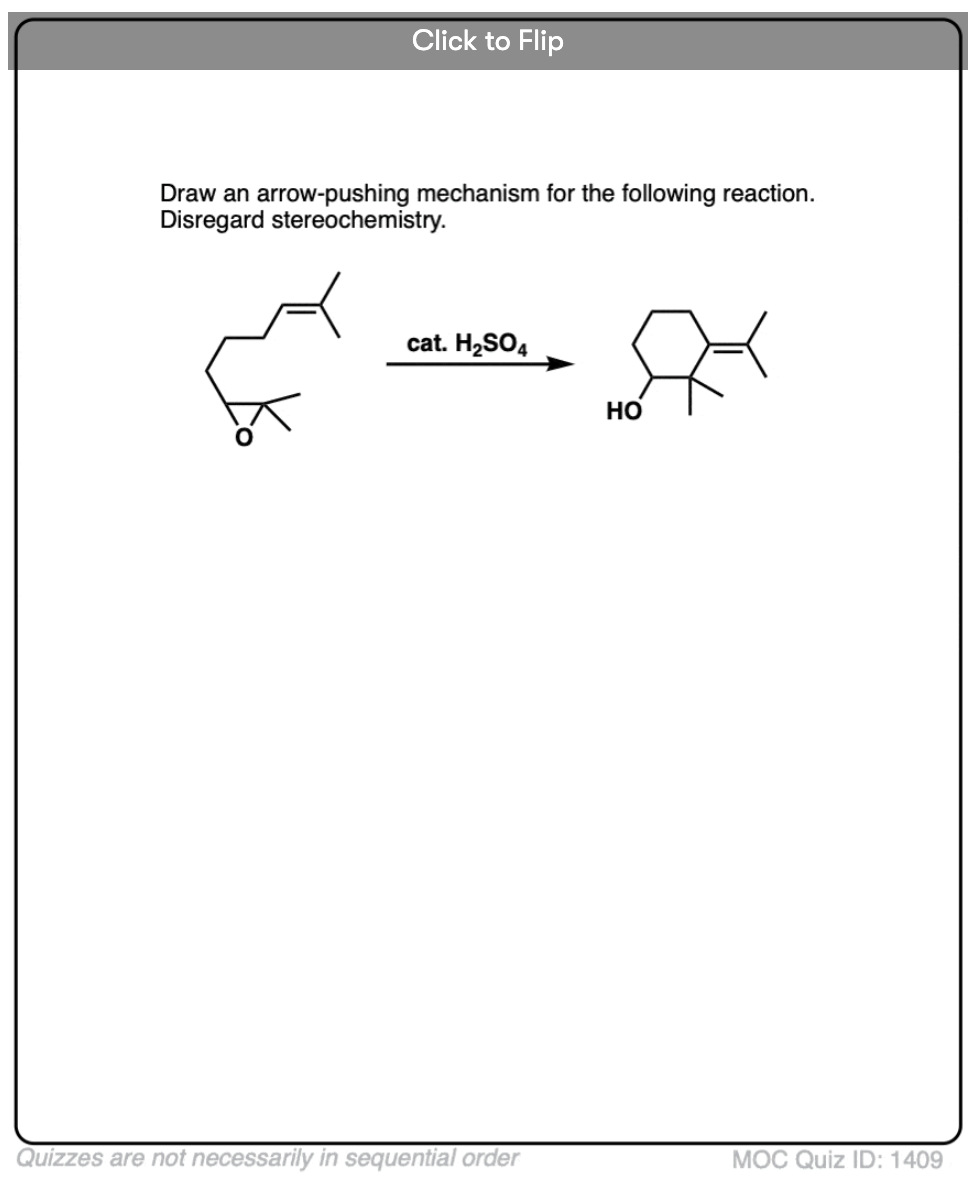
Become a MOC member to see the clickable quiz with answers on the back.
(Advanced) References and Further Reading
- Mechanisms Of Epoxide Reactions
E. Parker and N. S. Isaacs
Chemical Reviews 1959, 59 (4), 737-799
DOI: 10.1021/cr50028a006
This review is old but starts with the basics in discussing reactions of epoxides. Both acidic and basic (nucleophilic) reactions are covered. - Synthetic Methods and Reactions; 681. Nafion-H-Catalyzed Hydration and Methanolysis of Epoxides
George A. Olah, Alexander P. Fung, David Meidar
Synthesis 1981; 1981 (4): 280-282
DOI: 1055/s-1981-29414
In this instance, NafionTM-H (a polymeric resin developed by DuPont and subsequently modified to the superacidic “-H” form by Prof. Olah) can be used as a catalyst to promote the hydrolytic ring-opening of epoxides to 1,2-diols. - Friedel-Crafts Alkylations of Arenes with Mono- and Bis(trifluoromethyl)oxiranes in Superacid Medium: Facile Synthesis of α-(Trifluoromethyl)- and α,α-Bis(Trifluoromethyl)-β-Arylethanols
K. Surya Prakash, Pablo J. Linares-Palomino, Kevin Glinton, Sujith Chacko, Golam Rasul, Thomas Mathew, and George A. Olah
Synlett 2007, (7), 1158-1162
DOI: 10.1055/s-2007-977423
Under Brønsted acid conditions, epoxides can be used as electrophiles in Friedel-Crafts reactions. - Hot Water-Promoted Ring-Opening of Epoxides and Aziridines by Water and Other Nucleopliles
Zhi Wang, Yong-Tao Cui, Zhao-Bing Xu, and Jin Qu
The Journal of Organic Chemistry 2008, 73 (6), 2270-2274
DOI: 1021/jo702401t
The title has that typo, which makes me a bit suspicious. On the other hand, this is a JOC article, so it should be reliable. Turns out that hot water can hydrolyze epoxides to diols, no catalyst needed!Epoxides can undergo ring-opening under both acidic and basic conditions – i.e. under electrophilic and nucleophilic reaction conditions. To take this one step further, in acidic conditions, epoxides can be activated by both Brønsted and Lewis acids. Lewis acid catalysis is more common, and is described in the following publications: - Titanium isopropoxide-mediated nucleophilic openings of 2,3-epoxy alcohols. A mild procedure for regioselective ring-opening
Maurice Caron and K. B. Sharpless
The Journal of Organic Chemistry 1985, 50 (9), 1557-1560
DOI: 1021/jo00209a047 - Asymmetric Catalysis of Epoxide Ring-Opening Reactions
Eric N. Jacobsen
Accounts of Chemical Research 2000, 33 (6), 421-431
DOI: 1021/ar960061v
Prof. Jacobsen (Harvard) has made a career out of developing and studying asymmetric reactions. One of his notable contributions is the development of a Cr(salen) catalyst for the asymmetric ring-opening of epoxides, and the story of the development of this chemistry is described here. - Epoxide opening with tert-butyldimethylsilyl cyanide-zinc iodide. Evidence for a stepwise process in the opening of a sterically hindered epoxide
Paul G. Gassman and Leonard M. Haberman
The Journal of Organic Chemistry 1986, 51 (25), 5010-5013
DOI: 1021/jo00375a050
This is a study of an unusual but interesting reaction developed in the labs of the late Prof P. G. Gassman (U Minnesota). The reaction of epoxides with TMSCN (an organic-soluble and easier-to-handle substitute to traditional cyanide reagents such as KCN) and catalytic ZnI2 gives 1,2-isocyano alcohols. This paper is a mechanistic investigation of this reaction. - CONVERSION OF EPOXIDES TO β-HYDROXY ISOCYANIDES: trans-2-ISOCYANOCYCLOHEXANOL
Paul G. Gassman and Thomas L. Guggenheim
Org. Synth. 1986, 64, 39
DOI: 10.15227/orgsyn.064.0039
An Organic Syntheses procedure for the ring-opening of epoxides to 1,2-isocyano alcohols.
00 General Chemistry Review
01 Bonding, Structure, and Resonance
- How Do We Know Methane (CH4) Is Tetrahedral?
- Hybrid Orbitals and Hybridization
- How To Determine Hybridization: A Shortcut
- Orbital Hybridization And Bond Strengths
- Sigma bonds come in six varieties: Pi bonds come in one
- A Key Skill: How to Calculate Formal Charge
- The Four Intermolecular Forces and How They Affect Boiling Points
- 3 Trends That Affect Boiling Points
- How To Use Electronegativity To Determine Electron Density (and why NOT to trust formal charge)
- Introduction to Resonance
- How To Use Curved Arrows To Interchange Resonance Forms
- Evaluating Resonance Forms (1) - The Rule of Least Charges
- How To Find The Best Resonance Structure By Applying Electronegativity
- Evaluating Resonance Structures With Negative Charges
- Evaluating Resonance Structures With Positive Charge
- Exploring Resonance: Pi-Donation
- Exploring Resonance: Pi-acceptors
- In Summary: Evaluating Resonance Structures
- Drawing Resonance Structures: 3 Common Mistakes To Avoid
- How to apply electronegativity and resonance to understand reactivity
- Bond Hybridization Practice
- Structure and Bonding Practice Quizzes
- Resonance Structures Practice
02 Acid Base Reactions
- Introduction to Acid-Base Reactions
- Acid Base Reactions In Organic Chemistry
- The Stronger The Acid, The Weaker The Conjugate Base
- Walkthrough of Acid-Base Reactions (3) - Acidity Trends
- Five Key Factors That Influence Acidity
- Acid-Base Reactions: Introducing Ka and pKa
- How to Use a pKa Table
- The pKa Table Is Your Friend
- A Handy Rule of Thumb for Acid-Base Reactions
- Acid Base Reactions Are Fast
- pKa Values Span 60 Orders Of Magnitude
- How Protonation and Deprotonation Affect Reactivity
- Acid Base Practice Problems
03 Alkanes and Nomenclature
- Meet the (Most Important) Functional Groups
- Condensed Formulas: Deciphering What the Brackets Mean
- Hidden Hydrogens, Hidden Lone Pairs, Hidden Counterions
- Don't Be Futyl, Learn The Butyls
- Primary, Secondary, Tertiary, Quaternary In Organic Chemistry
- Branching, and Its Affect On Melting and Boiling Points
- The Many, Many Ways of Drawing Butane
- Wedge And Dash Convention For Tetrahedral Carbon
- Common Mistakes in Organic Chemistry: Pentavalent Carbon
- Table of Functional Group Priorities for Nomenclature
- Summary Sheet - Alkane Nomenclature
- Organic Chemistry IUPAC Nomenclature Demystified With A Simple Puzzle Piece Approach
- Boiling Point Quizzes
- Organic Chemistry Nomenclature Quizzes
04 Conformations and Cycloalkanes
- Staggered vs Eclipsed Conformations of Ethane
- Conformational Isomers of Propane
- Newman Projection of Butane (and Gauche Conformation)
- Introduction to Cycloalkanes
- Geometric Isomers In Small Rings: Cis And Trans Cycloalkanes
- Calculation of Ring Strain In Cycloalkanes
- Cycloalkanes - Ring Strain In Cyclopropane And Cyclobutane
- Cyclohexane Conformations
- Cyclohexane Chair Conformation: An Aerial Tour
- How To Draw The Cyclohexane Chair Conformation
- The Cyclohexane Chair Flip
- The Cyclohexane Chair Flip - Energy Diagram
- Substituted Cyclohexanes - Axial vs Equatorial
- Ranking The Bulkiness Of Substituents On Cyclohexanes: "A-Values"
- Cyclohexane Chair Conformation Stability: Which One Is Lower Energy?
- Fused Rings - Cis-Decalin and Trans-Decalin
- Naming Bicyclic Compounds - Fused, Bridged, and Spiro
- Bredt's Rule (And Summary of Cycloalkanes)
- Newman Projection Practice
- Cycloalkanes Practice Problems
05 A Primer On Organic Reactions
- The Most Important Question To Ask When Learning a New Reaction
- Curved Arrows (for reactions)
- Nucleophiles and Electrophiles
- The Three Classes of Nucleophiles
- Nucleophilicity vs. Basicity
- What Makes A Good Nucleophile?
- What Makes A Good Leaving Group?
- 3 Factors That Stabilize Carbocations
- Equilibrium and Energy Relationships
- 7 Factors that stabilize negative charge in organic chemistry
- 7 Factors That Stabilize Positive Charge in Organic Chemistry
- What's a Transition State?
- Hammond's Postulate
- Learning Organic Chemistry Reactions: A Checklist (PDF)
- Introduction to Oxidative Cleavage Reactions
06 Free Radical Reactions
- Free Radical Reactions
- 3 Factors That Stabilize Free Radicals
- Bond Strengths And Radical Stability
- Free Radical Initiation: Why Is "Light" Or "Heat" Required?
- Initiation, Propagation, Termination
- Monochlorination Products Of Propane, Pentane, And Other Alkanes
- Selectivity In Free Radical Reactions
- Selectivity in Free Radical Reactions: Bromination vs. Chlorination
- Halogenation At Tiffany's
- Allylic Bromination
- Bonus Topic: Allylic Rearrangements
- In Summary: Free Radicals
- Synthesis (2) - Reactions of Alkanes
- Free Radicals Practice Quizzes
07 Stereochemistry and Chirality
- Types of Isomers: Constitutional Isomers, Stereoisomers, Enantiomers, and Diastereomers
- How To Draw The Enantiomer Of A Chiral Molecule
- How To Draw A Bond Rotation
- Introduction to Assigning (R) and (S): The Cahn-Ingold-Prelog Rules
- Assigning Cahn-Ingold-Prelog (CIP) Priorities (2) - The Method of Dots
- Enantiomers vs Diastereomers vs The Same? Two Methods For Solving Problems
- Assigning R/S To Newman Projections (And Converting Newman To Line Diagrams)
- How To Determine R and S Configurations On A Fischer Projection
- The Meso Trap
- Optical Rotation, Optical Activity, and Specific Rotation
- Optical Purity and Enantiomeric Excess
- What's a Racemic Mixture?
- Chiral Allenes And Chiral Axes
- Stereochemistry Practice Problems and Quizzes
08 Substitution Reactions
- Nucleophilic Substitution Reactions - Introduction
- Two Types of Nucleophilic Substitution Reactions
- The SN2 Mechanism
- Why the SN2 Reaction Is Powerful
- The SN1 Mechanism
- The Conjugate Acid Is A Better Leaving Group
- Comparing the SN1 and SN2 Reactions
- Polar Protic? Polar Aprotic? Nonpolar? All About Solvents
- Steric Hindrance is Like a Fat Goalie
- Common Blind Spot: Intramolecular Reactions
- Substitution Practice - SN1
- Substitution Practice - SN2
09 Elimination Reactions
- Elimination Reactions (1): Introduction And The Key Pattern
- Elimination Reactions (2): The Zaitsev Rule
- Elimination Reactions Are Favored By Heat
- Two Elimination Reaction Patterns
- The E1 Reaction
- The E2 Mechanism
- E1 vs E2: Comparing the E1 and E2 Reactions
- Antiperiplanar Relationships: The E2 Reaction and Cyclohexane Rings
- Bulky Bases in Elimination Reactions
- Comparing the E1 vs SN1 Reactions
- Elimination (E1) Reactions With Rearrangements
- E1cB - Elimination (Unimolecular) Conjugate Base
- Elimination (E1) Practice Problems And Solutions
- Elimination (E2) Practice Problems and Solutions
10 Rearrangements
11 SN1/SN2/E1/E2 Decision
- Identifying Where Substitution and Elimination Reactions Happen
- Deciding SN1/SN2/E1/E2 (1) - The Substrate
- Deciding SN1/SN2/E1/E2 (2) - The Nucleophile/Base
- SN1 vs E1 and SN2 vs E2 : The Temperature
- Deciding SN1/SN2/E1/E2 - The Solvent
- Wrapup: The Key Factors For Determining SN1/SN2/E1/E2
- Alkyl Halide Reaction Map And Summary
- SN1 SN2 E1 E2 Practice Problems
12 Alkene Reactions
- E and Z Notation For Alkenes (+ Cis/Trans)
- Alkene Stability
- Alkene Addition Reactions: "Regioselectivity" and "Stereoselectivity" (Syn/Anti)
- Stereoselective and Stereospecific Reactions
- Hydrohalogenation of Alkenes and Markovnikov's Rule
- Hydration of Alkenes With Aqueous Acid
- Rearrangements in Alkene Addition Reactions
- Halogenation of Alkenes and Halohydrin Formation
- Oxymercuration Demercuration of Alkenes
- Hydroboration Oxidation of Alkenes
- m-CPBA (meta-chloroperoxybenzoic acid)
- OsO4 (Osmium Tetroxide) for Dihydroxylation of Alkenes
- Palladium on Carbon (Pd/C) for Catalytic Hydrogenation of Alkenes
- Cyclopropanation of Alkenes
- A Fourth Alkene Addition Pattern - Free Radical Addition
- Alkene Reactions: Ozonolysis
- Summary: Three Key Families Of Alkene Reaction Mechanisms
- Synthesis (4) - Alkene Reaction Map, Including Alkyl Halide Reactions
- Alkene Reactions Practice Problems
13 Alkyne Reactions
- Acetylides from Alkynes, And Substitution Reactions of Acetylides
- Partial Reduction of Alkynes With Lindlar's Catalyst
- Partial Reduction of Alkynes With Na/NH3 To Obtain Trans Alkenes
- Alkyne Hydroboration With "R2BH"
- Hydration and Oxymercuration of Alkynes
- Hydrohalogenation of Alkynes
- Alkyne Halogenation: Bromination and Chlorination of Alkynes
- Oxidation of Alkynes With O3 and KMnO4
- Alkenes To Alkynes Via Halogenation And Elimination Reactions
- Alkynes Are A Blank Canvas
- Synthesis (5) - Reactions of Alkynes
- Alkyne Reactions Practice Problems With Answers
14 Alcohols, Epoxides and Ethers
- Alcohols - Nomenclature and Properties
- Alcohols Can Act As Acids Or Bases (And Why It Matters)
- Alcohols - Acidity and Basicity
- The Williamson Ether Synthesis
- Ethers From Alkenes, Tertiary Alkyl Halides and Alkoxymercuration
- Alcohols To Ethers via Acid Catalysis
- Cleavage Of Ethers With Acid
- Epoxides - The Outlier Of The Ether Family
- Opening of Epoxides With Acid
- Epoxide Ring Opening With Base
- Making Alkyl Halides From Alcohols
- Tosylates And Mesylates
- PBr3 and SOCl2
- Elimination Reactions of Alcohols
- Elimination of Alcohols To Alkenes With POCl3
- Alcohol Oxidation: "Strong" and "Weak" Oxidants
- Demystifying The Mechanisms of Alcohol Oxidations
- Protecting Groups For Alcohols
- Thiols And Thioethers
- Calculating the oxidation state of a carbon
- Oxidation and Reduction in Organic Chemistry
- Oxidation Ladders
- SOCl2 Mechanism For Alcohols To Alkyl Halides: SN2 versus SNi
- Alcohol Reactions Roadmap (PDF)
- Alcohol Reaction Practice Problems
- Epoxide Reaction Quizzes
- Oxidation and Reduction Practice Quizzes
15 Organometallics
- What's An Organometallic?
- Formation of Grignard and Organolithium Reagents
- Organometallics Are Strong Bases
- Reactions of Grignard Reagents
- Protecting Groups In Grignard Reactions
- Synthesis Problems Involving Grignard Reagents
- Grignard Reactions And Synthesis (2)
- Organocuprates (Gilman Reagents): How They're Made
- Gilman Reagents (Organocuprates): What They're Used For
- The Heck, Suzuki, and Olefin Metathesis Reactions (And Why They Don't Belong In Most Introductory Organic Chemistry Courses)
- Reaction Map: Reactions of Organometallics
- Grignard Practice Problems
16 Spectroscopy
- Degrees of Unsaturation (or IHD, Index of Hydrogen Deficiency)
- Conjugation And Color (+ How Bleach Works)
- Introduction To UV-Vis Spectroscopy
- UV-Vis Spectroscopy: Absorbance of Carbonyls
- UV-Vis Spectroscopy: Practice Questions
- Bond Vibrations, Infrared Spectroscopy, and the "Ball and Spring" Model
- Infrared Spectroscopy: A Quick Primer On Interpreting Spectra
- IR Spectroscopy: 4 Practice Problems
- 1H NMR: How Many Signals?
- Homotopic, Enantiotopic, Diastereotopic
- Diastereotopic Protons in 1H NMR Spectroscopy: Examples
- 13-C NMR - How Many Signals
- Liquid Gold: Pheromones In Doe Urine
- Natural Product Isolation (1) - Extraction
- Natural Product Isolation (2) - Purification Techniques, An Overview
- Structure Determination Case Study: Deer Tarsal Gland Pheromone
17 Dienes and MO Theory
- What To Expect In Organic Chemistry 2
- Are these molecules conjugated?
- Conjugation And Resonance In Organic Chemistry
- Bonding And Antibonding Pi Orbitals
- Molecular Orbitals of The Allyl Cation, Allyl Radical, and Allyl Anion
- Pi Molecular Orbitals of Butadiene
- Reactions of Dienes: 1,2 and 1,4 Addition
- Thermodynamic and Kinetic Products
- More On 1,2 and 1,4 Additions To Dienes
- s-cis and s-trans
- The Diels-Alder Reaction
- Cyclic Dienes and Dienophiles in the Diels-Alder Reaction
- Stereochemistry of the Diels-Alder Reaction
- Exo vs Endo Products In The Diels Alder: How To Tell Them Apart
- HOMO and LUMO In the Diels Alder Reaction
- Why Are Endo vs Exo Products Favored in the Diels-Alder Reaction?
- Diels-Alder Reaction: Kinetic and Thermodynamic Control
- The Retro Diels-Alder Reaction
- The Intramolecular Diels Alder Reaction
- Regiochemistry In The Diels-Alder Reaction
- The Cope and Claisen Rearrangements
- Electrocyclic Reactions
- Electrocyclic Ring Opening And Closure (2) - Six (or Eight) Pi Electrons
- Diels Alder Practice Problems
- Molecular Orbital Theory Practice
18 Aromaticity
- Introduction To Aromaticity
- Rules For Aromaticity
- Huckel's Rule: What Does 4n+2 Mean?
- Aromatic, Non-Aromatic, or Antiaromatic? Some Practice Problems
- Antiaromatic Compounds and Antiaromaticity
- The Pi Molecular Orbitals of Benzene
- The Pi Molecular Orbitals of Cyclobutadiene
- Frost Circles
- Aromaticity Practice Quizzes
19 Reactions of Aromatic Molecules
- Electrophilic Aromatic Substitution: Introduction
- Activating and Deactivating Groups In Electrophilic Aromatic Substitution
- Electrophilic Aromatic Substitution - The Mechanism
- Ortho-, Para- and Meta- Directors in Electrophilic Aromatic Substitution
- Understanding Ortho, Para, and Meta Directors
- Why are halogens ortho- para- directors?
- Disubstituted Benzenes: The Strongest Electron-Donor "Wins"
- Electrophilic Aromatic Substitutions (1) - Halogenation of Benzene
- Electrophilic Aromatic Substitutions (2) - Nitration and Sulfonation
- EAS Reactions (3) - Friedel-Crafts Acylation and Friedel-Crafts Alkylation
- Intramolecular Friedel-Crafts Reactions
- Nucleophilic Aromatic Substitution (NAS)
- Nucleophilic Aromatic Substitution (2) - The Benzyne Mechanism
- Reactions on the "Benzylic" Carbon: Bromination And Oxidation
- The Wolff-Kishner, Clemmensen, And Other Carbonyl Reductions
- More Reactions on the Aromatic Sidechain: Reduction of Nitro Groups and the Baeyer Villiger
- Aromatic Synthesis (1) - "Order Of Operations"
- Synthesis of Benzene Derivatives (2) - Polarity Reversal
- Aromatic Synthesis (3) - Sulfonyl Blocking Groups
- Birch Reduction
- Synthesis (7): Reaction Map of Benzene and Related Aromatic Compounds
- Aromatic Reactions and Synthesis Practice
- Electrophilic Aromatic Substitution Practice Problems
20 Aldehydes and Ketones
- What's The Alpha Carbon In Carbonyl Compounds?
- Nucleophilic Addition To Carbonyls
- Aldehydes and Ketones: 14 Reactions With The Same Mechanism
- Sodium Borohydride (NaBH4) Reduction of Aldehydes and Ketones
- Grignard Reagents For Addition To Aldehydes and Ketones
- Wittig Reaction
- Hydrates, Hemiacetals, and Acetals
- Imines - Properties, Formation, Reactions, and Mechanisms
- All About Enamines
- Breaking Down Carbonyl Reaction Mechanisms: Reactions of Anionic Nucleophiles (Part 2)
- Aldehydes Ketones Reaction Practice
21 Carboxylic Acid Derivatives
- Nucleophilic Acyl Substitution (With Negatively Charged Nucleophiles)
- Addition-Elimination Mechanisms With Neutral Nucleophiles (Including Acid Catalysis)
- Basic Hydrolysis of Esters - Saponification
- Transesterification
- Proton Transfer
- Fischer Esterification - Carboxylic Acid to Ester Under Acidic Conditions
- Lithium Aluminum Hydride (LiAlH4) For Reduction of Carboxylic Acid Derivatives
- LiAlH[Ot-Bu]3 For The Reduction of Acid Halides To Aldehydes
- Di-isobutyl Aluminum Hydride (DIBAL) For The Partial Reduction of Esters and Nitriles
- Amide Hydrolysis
- Thionyl Chloride (SOCl2) And Conversion of Carboxylic Acids to Acid Halides
- Diazomethane (CH2N2)
- Carbonyl Chemistry: Learn Six Mechanisms For the Price Of One
- Making Music With Mechanisms (PADPED)
- Carboxylic Acid Derivatives Practice Questions
22 Enols and Enolates
- Keto-Enol Tautomerism
- Enolates - Formation, Stability, and Simple Reactions
- Kinetic Versus Thermodynamic Enolates
- Aldol Addition and Condensation Reactions
- Reactions of Enols - Acid-Catalyzed Aldol, Halogenation, and Mannich Reactions
- Claisen Condensation and Dieckmann Condensation
- Decarboxylation
- The Malonic Ester and Acetoacetic Ester Synthesis
- The Michael Addition Reaction and Conjugate Addition
- The Robinson Annulation
- Haloform Reaction
- The Hell–Volhard–Zelinsky Reaction
- Enols and Enolates Practice Quizzes
23 Amines
- The Amide Functional Group: Properties, Synthesis, and Nomenclature
- Basicity of Amines And pKaH
- 5 Key Basicity Trends of Amines
- The Mesomeric Effect And Aromatic Amines
- Nucleophilicity of Amines
- Alkylation of Amines (Sucks!)
- Reductive Amination
- The Gabriel Synthesis
- Some Reactions of Azides
- The Hofmann Elimination
- The Hofmann and Curtius Rearrangements
- The Cope Elimination
- Protecting Groups for Amines - Carbamates
- The Strecker Synthesis of Amino Acids
- Introduction to Peptide Synthesis
- Reactions of Diazonium Salts: Sandmeyer and Related Reactions
- Amine Practice Questions
24 Carbohydrates
- D and L Notation For Sugars
- Pyranoses and Furanoses: Ring-Chain Tautomerism In Sugars
- What is Mutarotation?
- Reducing Sugars
- The Big Damn Post Of Carbohydrate-Related Chemistry Definitions
- The Haworth Projection
- Converting a Fischer Projection To A Haworth (And Vice Versa)
- Reactions of Sugars: Glycosylation and Protection
- The Ruff Degradation and Kiliani-Fischer Synthesis
- Isoelectric Points of Amino Acids (and How To Calculate Them)
- Carbohydrates Practice
- Amino Acid Quizzes
25 Fun and Miscellaneous
- A Gallery of Some Interesting Molecules From Nature
- Screw Organic Chemistry, I'm Just Going To Write About Cats
- On Cats, Part 1: Conformations and Configurations
- On Cats, Part 2: Cat Line Diagrams
- On Cats, Part 4: Enantiocats
- On Cats, Part 6: Stereocenters
- Organic Chemistry Is Shit
- The Organic Chemistry Behind "The Pill"
- Maybe they should call them, "Formal Wins" ?
- Why Do Organic Chemists Use Kilocalories?
- The Principle of Least Effort
- Organic Chemistry GIFS - Resonance Forms
- Reproducibility In Organic Chemistry
- What Holds The Nucleus Together?
- How Reactions Are Like Music
- Organic Chemistry and the New MCAT
26 Organic Chemistry Tips and Tricks
- Common Mistakes: Formal Charges Can Mislead
- Partial Charges Give Clues About Electron Flow
- Draw The Ugly Version First
- Organic Chemistry Study Tips: Learn the Trends
- The 8 Types of Arrows In Organic Chemistry, Explained
- Top 10 Skills To Master Before An Organic Chemistry 2 Final
- Common Mistakes with Carbonyls: Carboxylic Acids... Are Acids!
- Planning Organic Synthesis With "Reaction Maps"
- Alkene Addition Pattern #1: The "Carbocation Pathway"
- Alkene Addition Pattern #2: The "Three-Membered Ring" Pathway
- Alkene Addition Pattern #3: The "Concerted" Pathway
- Number Your Carbons!
- The 4 Major Classes of Reactions in Org 1
- How (and why) electrons flow
- Grossman's Rule
- Three Exam Tips
- A 3-Step Method For Thinking Through Synthesis Problems
- Putting It Together
- Putting Diels-Alder Products in Perspective
- The Ups and Downs of Cyclohexanes
- The Most Annoying Exceptions in Org 1 (Part 1)
- The Most Annoying Exceptions in Org 1 (Part 2)
- The Marriage May Be Bad, But the Divorce Still Costs Money
- 9 Nomenclature Conventions To Know
- Nucleophile attacks Electrophile
27 Case Studies of Successful O-Chem Students
- Success Stories: How Corina Got The The "Hard" Professor - And Got An A+ Anyway
- How Helena Aced Organic Chemistry
- From a "Drop" To B+ in Org 2 – How A Hard Working Student Turned It Around
- How Serge Aced Organic Chemistry
- Success Stories: How Zach Aced Organic Chemistry 1
- Success Stories: How Kari Went From C– to B+
- How Esther Bounced Back From a "C" To Get A's In Organic Chemistry 1 And 2
- How Tyrell Got The Highest Grade In Her Organic Chemistry Course
- This Is Why Students Use Flashcards
- Success Stories: How Stu Aced Organic Chemistry
- How John Pulled Up His Organic Chemistry Exam Grades
- Success Stories: How Nathan Aced Organic Chemistry (Without It Taking Over His Life)
- How Chris Aced Org 1 and Org 2
- Interview: How Jay Got an A+ In Organic Chemistry
- How to Do Well in Organic Chemistry: One Student's Advice
- "America's Top TA" Shares His Secrets For Teaching O-Chem
- "Organic Chemistry Is Like..." - A Few Metaphors
- How To Do Well In Organic Chemistry: Advice From A Tutor
- Guest post: "I went from being afraid of tests to actually looking forward to them".
I have seen that if a Grignard reagent is added to the epoxide, its addition takes place at the less substituted carbon, and acidic workup gives alcohol as a product.
But what if the epoxide is protonated first (activated), and Grignard reagent is added later, would it still add at the less substituted carbon, or would addition take place at the more substituted carbon, like that of epoxide opening in acidic medium.
If the epoxide is protonated first, the acid will destroy the Grignard. It’s possible to accelerate Grignard-type additions to epoxides with Lewis acids (e.g. BF3) that are compatible with strong bases.
In your magnificient chart summary of all the reaction, you may have forgotten
70: Acidic ring opening of epoxides
can you please help me with how epoxide regioselectively open in the presence of an lewis acid like BF3.Et2O .
Similar. Lewis acid coordinates to one of the lone pairs of the epoxide, and then a nucleophile will attack at the more substituted position.
Hi
Are carbocation rearrangements possible in acidic opening of epoxides? Or is the carbocation never really formed, just a direct attack on the cyclic intermediate?
No, they wouldn’t be carbocation rearrangements, in acidic opening of epoxides, because there likely won’t be a free carbocation.
However, there are pinacol-related rearrangements that can occur with epoxides when acid is added in the absence of nucleophiles, such as the epoxide-aldehyde rearrangement.
When CH3-CH=CH-OCH3 reacts with HBr what will be the product.
Start drawing resonance forms. You will quickly find a species which is a good nucleophile on carbon. That will tell you where it will react with an electrophile, and from there you can figure out the product.
Bro grignard reagents and Gilman reagents (organolithium reagents) give R- which is a base not acid. Bases with epoxides go through sn2
Suppose if grignard reagent is first treated with epoxycyclohexane and than protonated.
What will be the mechanism..
Dear James,
Under Note 1, you state that the nucleophile attacks the MORE substituted carbon. In your examples, you show a tertiary carbon being attacked in the protonated epoxide. How is this possible? I have always learned that a tertiary substrate cannot undergo an SN2 reaction due to steric hindrance.
In fact, my textbook states that if you react an epoxide with Grignard or organolithium reagents, the reagents would attack the LESS hindered epoxide carbon atom.
Hello, what if you have a cyclohexane ring with a epoxide on it with a methyl groupattached to one of the carbons bonded to the epoxide and is reacting with a Acetylide anion and water. Will there be stereochemistry even though the acetylide anion is linear.
The acetylide ion is a basic nucleophile and will attack the least substituted carbon in SN2 fashion. The water is added after the reaction is over to quench the alkoxide anion.
One doubt Professor….. can NaBH4 open an epoxide????
Thanks!
Generally not. LiBH4 can do it.
explain the mechanism of 1,2 epoxy propane reaction with Hcl
OK, so what’s the strongest base? The epoxide oxygen. So protonate the oxygen, forming a new O-H bond and breaking the H-Cl bond. Now you have a protonated epoxide with a Cl- floating around. Cl- can be a good nucleophile. So what happens next?
If an amine is reacted with an epoxy in the presence of acid in an aqueous system, the acid can protonate the amine lone pair nucleophile and actually slow the reaction between the amine and epoxy. How do you account for this phenomenon per your illustrations, in which the acid is shown to accelerate the reaction?
Amines are at least 10 orders of magnitude more basic than epoxides, so any acid added to the system will protonate the amine, not the epoxide. Protonating the amine makes it into an ammonium salt, which is non-nucleophilic. That’s why the reaction slows down. Acid slows down the rate of addition of Grignards to epoxides too.
Just pointing it out, the article refers to Note #2 which doesn’t exist. Also, the link at the bottom is broken.
Would be great if someone could answer how come the carbon that gets more electron density from its surrounding groups (thus better able to stabilize positive charge) is more positive (even though it gets more electron density).
This is my sleep-deprived guesswork and probably wrong, but I’ll put forward some possible factors revolving around the intermediate trying to lower it’s free-energy. Remember that a carbon bonded to a highly electronegative atom is going to be partially positive even if it had THREE alkyl groups attached. Note: when I say carbons in this post I’m referring to the annular atoms as opposed to the methyl substituent.
Realize this is essentially the same dilemma and reasoning involved in another three-membered ring pathway: Opening an epoxide with Br2 & H2O to form a halohydrin. Keep in mind the drawings don’t capture that the ring bends side to side, or you can think of the electroneg. atom able to tilt towards one carbon or the other, or as resonance structures. There are pictures of this in Klein’s First Semester, 3rd ed. p.290 and here http://images.slideplayer.com/16/5221039/slides/slide_74.jpg , here http://images.slideplayer.com/25/7654562/slides/slide_3.jpg ,
and here http://courses.chem.psu.edu/chem210/mol-gallery/bromonium/bromonium.html
The intermediate is VERY unstable. The Bromine, or Oxygen in this case, and carbons involved got suckered into this situation, and they have to deal with it the best they can. They have no idea they will be relieved by Nuc attack in the future; they just want to be as stable as possible at the moment. Which means dealing with the ring strain, steric hindrance, and key to understanding here: The positive charge; it’s gotta go SOMEWHERE! And the O will be G*d*mned if it’s gonna be the one to bear it.
*Mnemonically, OJ doesn’t want a positive charge to stick on him, so he tries whatever he can until they find “The real killer” (Nuc attacker), including leaning on Johnnie Cochran (Carbon). Lots of possibilities for those old enough to remember. (Kato Kaelin ~ Carbocation…eh?)
1) Think of the Br or O as a suddenly trapped frightened animal whose panicking instinct is to do what it knows, which is to completely go to only one carbon or the other to form a carbocation–a structure more stable with the positive charge at the more substituted carbon. This would alter the more substituted carbon from sp3 to sp2, and from tertiary to secondary, making an SN2 attack possible there…Imagine O tries to do this with its burly arms holding on to each carbon’s electrons the whole time. As O leans and stretches to one side, it pulls the electron density with it (another reason it would be bad if O were instead pulling it towards the carbon with the most original/prior electron density). But as strong as O pulls, this ring…can’t…quite…be broken. Still, it’s enough to render SOME sp2 and secondary character to the more substituted carbon. Though it’s not the desired carbocation, this causes the more substituted carbon to gain just enough of this character and just enough partial positive charge to allow for it to be the electrophilic site (especially as its electrons get more and more repelled by the approaching electrons of the Nuc as it gets closer and closer).
2) If we’re focusing only on the intermediate here, then maybe steric hindrance between the lone pairs of O and the methyl substituent…?
3) Maybe moving towards one side will decrease the angle of O further, thereby lessening electron-electron repulsion between it’s lone pairs and bonds (with the further decrease from ideal sp3 angle balanced by the increase in the angle of the less substituted carbon)…?
Thank you, Bo, for taking the time to write out a long explanation to help a reader.
I want to know i want to introduce other group in epoxy like nitro group so what would i do first to open ring and introduce or add when epoxy is make?
You’d start with the appropriately substituted alkene and then do an epoxidation reaction. For acrylonitrile you’d need a nucleophilic epoxidizing reagent like H2O2/NaOH.
hi james,
i really love your blog. its helped me a lot.
just had a question,
u have said that the charge on teriary carbon will be most,
whats wrong in saying that the positive charge on the tertiary carbon will be reduced due to the inductive effect of the alkyl groups..?and so it will have the least positive charge..
The inductive effects of neighboring alkyl groups only stabilize the positive charge by sharing their electrons through sigma bonds by induction. They do not change the polarity of the affected carbon, only stabilize it. I think Dr. James used a good analogy with the poor man surrounded by rich neighbors who can ‘tolerate’ being poor because the rich neighbors are willing to share what they got. This does not make the poor man rich but better than a poor man with poor neighbors.
This has confused me too ever since I learned about it..
How does the tertiary carbon that is stabilized through inductive effects (by electron donating groups) have less electron density than the secondary carbon?
Shouldn’t it be the other way around?
Your comparison to opening an epoxide under basic conditions was very helpful. My textbook did a poor job at explaining the difference in the product. Thank you.
Happy to help!
Hello James-san
A small question: when opening epoxides with acid, the first step is protonation, then the attack. But if I added excess acid ( like HI or HBr) to an unopened epoxide, would I observe the usual opening of epoxide? Can the final product ( an opened epoxide ) get protonated further by the acid?
( thanks loads for the cool site )
Addition of HBr or HI to alcohols will, eventually, convert them to alkyl halides, so yes, if you opened the epoxide to get a halohydrin, excess HBr or HI would eventually convert the R-OH to R-X where X is Br or I. Not sure why you’d want to do that but it’s doable.
Hi James,
What if the epoxide was treated in excess water after the addition of the Br from HBr? Could the excess water convert the Br to R-OH?
With water, not likely. You’d need a stronger nucleophile. If it was slightly basic, then some hydroxide ions could add as a nucleophile.